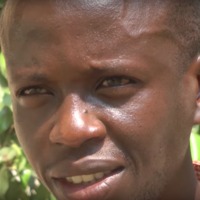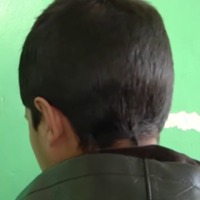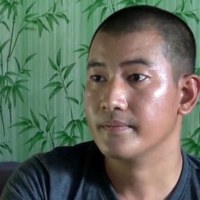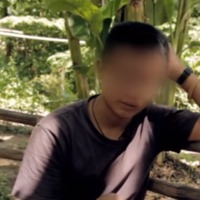
Musa
There are an estimated 36,000 people living in conditions of modern slavery in Sierra Leone (GSI 2018). Sierra Leone is a source and destination country for men, women and children subjected to forced labour and sex trafficking. During the Sierra Leone Civil War 1991 to 2002 the Revolutionary United Front (RUF) sought to mobilise a youth underclass to form a ‘people’s army’ to overthrow the Momoh regime. The RUF abducted and trained numbers of captured youth to fight as child soldiers in their guerrilla warfare. Musa, now about 20, was captured and forcibly inducted by the RUF/SL in a raid into north-western Sierra Leone in January 1995. Although he completed guerrilla training and served on operations, he never gained any promotion in the movement, remaining ambivalent about the struggle. He is frank that his lack of conviction was more a question of the hardship than of any political objection. He found that the RUF's ideological teaching about the state of Sierra Leone made sense. When interviewed in October 1996 he had managed to escape four weeks previously, after nearly two years, and had been re-accepted in his home community, a town not badly affected by the war. Musa provides a remarkable account of RUF/SL aims and operations, and of life in one of the guerrilla camps. In some respects, the account supports the picture the movement paints in its own propaganda document (RUFSL, 1995). The Gurkhas referred to in the account were a mercenary force of ex-Gurkhas led by a Canadian Vietnam veteran [Colonel Robert Mackenzie] hired by the NPRC government. Mackenzie was killed, and the survivors were withdrawn shortly afterwards, to be replaced by the South African private security firm Executive Outcomes.]

Gabriel
There are an estimated 36,000 people living in conditions of modern slavery in Sierra Leone (GSI 2018). Sierra Leone is a source and destination country for men, women and children subjected to forced labour and sex trafficking. During the Sierra Leone Civil War 1991 to 2002 the Revolutionary United Front (RUF) sought to mobilise a youth underclass to form a ‘people’s army’ to overthrow the Momoh regime. The RUF abducted and trained numbers of captured youth to fight as child soldiers in their guerrilla warfare. Gabriel* was captured as a youth in a raid by the Revolutionary United Front (RUF) in Sierra Leone. Gabriel tells of how he escaped from the militant forces after being held for a week.

Saw Htoo
According to the Global Slavery Index, there are an estimated 575,000 people living in modern slavery in Myanmar (formerly Burma). Some Tatmadaw personnel, civilian brokers, border guard officials, and EAGs continue to recruit or use child soldiers, particularly in conflict-affected ethnic areas. Civilian recruiters in some cases coerce or offer incentives to children or their families through false promises about working conditions, salary, and promotion opportunities. EAGs force men and boys to serve through intimidation, coercion, threats, arbitrary taxation, and violence. At the age of just 15, Saw Htoo was taken from him family and forcefully recruited into the Burmese military, the Tatmadaw.

Fabienne
According to the 2018 Global Slavery Index, there are approximately 408,000 people enslaved in Burundi. Amnesty International describes how military leaders have fuelled Burundi’s 10-year armed conflict by recruiting and abducting children. Poverty and years of armed conflict have made it easier for a whole generation of children to be drawn into the armed conflict. The Burundian armed forces as well as Burundian armed political groups have all recruited and used child soldiers in a variety of capacities - as porters, informants, “wives” and actual combatants. Fabienne* was forced to join an armed group at the age of 13 in 2001.

Grace Akello
There are an estimated 465,000 people living in modern slavery in Sudan (GSI 2018). Between 1983 and 2005, the central government of Sudan enslaved tens of thousands of black South Sudanese Christian and traditionalist people. It was part of a genocidal war against South Sudan, with a simple aim: to force South Sudan to become Arab and Muslim. Grace Akello was abducted from her high school dorm in October 1996 by the Lord’s Resistance Army. She, along with 29 other girls, was forced to march to Sudan under the threat of death if they could not keep up. Upon arrival, she was given an AK47 and told hunger would teach her to shoot. Grace was subjected to sexual violence for seven months before she was able to escape in April 1997.

Christian Kazungu
According to the 2018 Global Slavery Index, there are approximately 408,000 people enslaved in Burundi. Amnesty International describes how military leaders have fuelled Burundi’s 10 year armed conflict by recruiting and abducting children. Poverty and years of armed conflict have made it easier for a whole generation of children to be drawn into the armed conflict. The Burundian armed forces as well as Burundian armed political groups1 have all recruited and used child soldiers in a variety of capacities - as porters, informants, “wives” and actual combatants.Christian became a child soldier in Burundi when he was 11 years old.

Shadrack
In 1993, Burundi’s first democratically elected president was assassinated in a coup d’état. Melchior Ndadaye, of the majority Hutu ethnic group, had sought during his three months in office to ease tensions between Hutu and the minority Tutsi, which had ruled Burundi for decades and continued to dominate the army. In response, Hutu paramilitary groups formed, and as quid pro quo attacks between Hutu and Tutsi escalated, Burundi spiraled into civil war.Among the many victims of the war were children. Indignant over Ndadaye’s death and the denial of political power the Hutu believed their due, extremist factions exhorted teenagers and even younger children to join their ranks, and for more than a decade, thousands of children lived in Burundi’s forests in deplorable conditions, raiding villages, camps, and military installations, both suffering and committing horrific violence. Many were girls kept as sexual slaves for older soldiers. Shadrack joined the FNL rebellion after the army came to his village and killed a number of his relatives and neighbours, he was 13 years old. Shadrack tells of his experience as a child soldier and how he came to leave the rebellion.

David Ninteretse
In 1993, Burundi’s first democratically elected president was assassinated in a coup d’état. Melchior Ndadaye, of the majority Hutu ethnic group, had sought during his three months in office to ease tensions between Hutu and the minority Tutsi, which had ruled Burundi for decades and continued to dominate the army. In response, Hutu paramilitary groups formed, and as quid pro quo attacks between Hutu and Tutsi escalated, Burundi spiraled into civil war.Among the many victims of the war were children. Indignant over Ndadaye’s death and the denial of political power the Hutu believed their due, extremist factions exhorted teenagers and even younger children to join their ranks, and for more than a decade, thousands of children lived in Burundi’s forests in deplorable conditions, raiding villages, camps, and military installations, both suffering and committing horrific violence. Many were girls kept as sexual slaves for older soldiers David became involved in the Burundi Democratic Youth when he was 15 years old. After the coup in 1993, he became a Hutu child soldier, David tells of the hunger and abuse he faced as a child soldier as he was forced to walk barefoot for days with little food and water. David tells of his experience as a child soldier, his attempts to gain an education to become a political leader, and his retirement.

Habtu
There are an estimated 451,000 people living in modern slavery in Eritrea (GSI 2018). The small country has a unique system of compulsory, open-ended military service for citizens that makes it one of the most oppressive states in the world. The government has enforced its current policy of sending all secondary school students to serve for a minimum of twelve months since 2003. While Eritrean law puts the minimum conscription age at 18, many teenagers find themselves recruited during high school at age 16 or even younger. In rural areas, where formal education is rarer, the army will visit villages to round up young girls and boys who look roughly of age, to begin their program of combat training and forced labour. Habtu was taken to Sawa training camp in 2010. There he was forced to cook the soldier’s meals and was subjected to physical abuse daily.

Dawit B
There are an estimated 451,000 people living in modern slavery in Eritrea (GSI 2018). The small country has a unique system of compulsory, open-ended military service for citizens that makes it one of the most oppressive states in the world. The government has enforced its current policy of sending all secondary school students to serve for a minimum of twelve months since 2003. While Eritrean law puts the minimum conscription age at 18, many teenagers find themselves recruited during high school at age 16 or even younger. In rural areas, where formal education is rarer, the army will visit villages to round up young girls and boys who look roughly of age, to begin their program of combat training and forced labour. Dawit was 15 years old when he was taken to Sawa for military training. After finishing training he was able to escape back home and live in hiding. However, in 2010 when he tried to flee the country, he was caught and imprisoned for over a year.

Martin
There are an estimated 1,045,000 people living in conditions of modern slavery in the Democratic Republic of Congo (GSI 2018). In 2016 several armed groups continued to abduct and forcibly recruit men, women and children as combatants and in support roles such as guards, cleaners, cooks and spies. In 2016, 184 cases of child soldiers were reported, with 1,662 children reported to have separated or escaped from armed groups. Child soldiers who manage to escape remain vulnerable to re-recruitment as adequate rehabilitation services remain unavailable to children suffering trauma, stigmatisation and the continued threat of armed groups. Martin, a 16 year old Rwandan boy, was one of many children, boys and girls, lured into the M23 (Mouvement du 23 mars) under false pretences.

Dieudonne
There are an estimated 1,045,000 people living in conditions of modern slavery in the Democratic Republic of Congo (GSI 2018). In 2016 several armed groups continued to abduct and forcibly recruit men, women and children as combatants and in support roles such as guards, cleaners, cooks and spies. In 2016, 184 cases of child soldiers were reported, with 1,662 children reported to have separated or escaped from armed groups. Child soldiers who manage to escape remain vulnerable to re-recruitment as adequate rehabilitation services remain unavailable to children suffering trauma, stigmatisation and the continued threat of armed groups. Dieudonne was taken from his home in Burundi by militia forces and taken to the Congo to fight. Dieudonne was forced to cook and fight for the militia, he tells of how his best friend was killed while fighting.

Byaombe
There are an estimated 1,045,000 people living in conditions of modern slavery in the Democratic Republic of Congo (GSI 2018). In 2016 several armed groups continued to abduct and forcibly recruit men, women and children as combatants and in support roles such as guards, cleaners, cooks and spies. In 2016, 184 cases of child soldiers were reported, with 1,662 children reported to have separated or escaped from armed groups. Child soldiers who manage to escape remain vulnerable to re-recruitment as adequate rehabilitation services remain unavailable to children suffering trauma, stigmatisation and the continued threat of armed groups. Byaombe tells of his experience of being a child soldier for the FDD militia in the Democratic Republic of Congo. He tells of how he was taught to kill, how he was given drugs and how there was little food or shelter at the military camp.

Madeleine
There are an estimated 1,045,000 people living in conditions of modern slavery in the Democratic Republic of Congo (GSI 2018). In 2016 several armed groups continued to abduct and forcibly recruit men, women and children as combatants and in support roles such as guards, cleaners, cooks and spies. In 2016, 184 cases of child soldiers were reported, with 1,662 children reported to have separated or escaped from armed groups. Child soldiers who manage to escape remain vulnerable to re-recruitment as adequate rehabilitation services remain unavailable to children suffering trauma, stigmatisation and the continued threat of armed groups. Madeleine was abducted by militia in her village in the Democratic Republic of Congo when she was 12 years old. She tells of how she was taught to kill, how she was given drugs and alcohol to numb their feelings. Madeleine was a child soldier for two years before she was rescued.

John B
There are an estimated 1,045,000 people living in conditions of modern slavery in the Democratic Republic of Congo (GSI 2018). In 2016 several armed groups continued to abduct and forcibly recruit men, women and children as combatants and in support roles such as guards, cleaners, cooks and spies. In 2016, 184 cases of child soldiers were reported, with 1,662 children reported to have seperated or escaped from armed groups. Child soldiers who manage to escape remain vulnerable to re-recruitment as adeqaute rehabilitation services remain unavailable to children suffering trauma, stigmatisation and the continued threat of armed groups. John was abducted at nine years old when militia attacked his village. He was forced to become a child soldier. John was beaten each time he tried to escape. He finally managed to escape 3 weeks ago (2012) to a UN military base before dawn. It had been 6 years. Now he is at a transition centre for child soldiers.

Michel Chikwanine
There are an estimated 1,045,000 people living in conditions of modern slavery in the Democratic Republic of Congo (GSI 2018). In 2016 several armed groups continued to abduct and forcibly recruit men, women and children as combatants and in support roles such as guards, cleaners, cooks and spies. In 2016, 184 cases of child soldiers were reported, with 1,662 children reported to have seperated or escaped from armed groups. Child soldiers who manage to escape remain vulnerable to re-recruitment as adeqaute rehabilitation services remain unavailable to children suffering trauma, stigmatisation and the continued threat of armed groups. Michel Chikwanine was 5 years old when he was abducted by rebel soldiers while playing football with his friends. Driven for hours to an unknown location, when Michel and his friends finally stepped out of the trucks, they were drugged, blindfolded, given guns, and forced to shoot each other. For two weeks Michel was subjected to ‘training’ and then taken with other child soldiers to ‘take over’ a village. Michel was able to escape, running for 3 days and 3 nights through the jungle back to his home village. Michel now lives in Canada and is studying at university alongside working as a survivor advocate to eradicate the use of child soldiers.

Yahya
Afghanistan is a source, transit, and destination country for men, women, and children trafficked for the purposes of forced labour and commercial sexual exploitation. Afghan boys and girls are trafficked within the country for commercial sexual exploitation, forced marriage to settle debts or disputes, forced begging, as well as forced labour or debt bondage in brick kilns, carpet-making factories, and domestic service. Afghan children are also trafficked to Iran and Pakistan for forced labuor, particularly in Pakistan’s carpet factories, and forced marriage. Moreover, both government and non-state groups use children in combat, with the Taliban forcibly recruiting and using children as suicide bombers. 11 year old Yahya was living in poverty when he was sold by his parents to smugglers in Afghanistan. He was then handed over to the Taliban and was trained as a suicide bomber. However, rather than carry out what he had been trained for, Yahya surrendered himself to Afghan security forces. He is now in the care of the Afghan state.

Aung Ko Htway
Within Myanmar, some military personnel, civilian brokers, border guard officials and ethnic armed group continue to recruit or use child solders. In some cases, recruiters use deception, offering incentives or coercing children or their families through false promises about working conditions, salary, and promotion opportunities. While Human Rights Watch have noted that there is no way to precisely estimate the number of children in Burma's army, and while there is an ongoing process to end the forced recruitment of underaged children, there remain numerous accounts proving that the use of child soldiers continues among the 500,000 troops in the country. Aung Ko Htway was abducted when he was a teenager and forced to serve in the Myanmar army for nearly 10 years.

Saw Htoo
Within Burma, some military personnel, civilian brokers, border guard officials and ethnic armed group continue to recruit or use child solders. In some cases, recruiters use deception, offering incentives or coercing children or their families through false promises about working conditions, salary, and promotion opportunities. While Human Rights Watch have noted that there is no way to precisely estimate the number of children in Burma's army, and while there is an ongoing process to end the forced recruitment of underaged children, there remain numerous accounts proving that the use of child soldiers continues among the 500,000 troops in the country. Saw Htoo, 16 years old, was forced to join the Dkba army as a child soldier. Not wanting to fight against his own people, Saw Htoo defected and is now in the care of the Karen National Union.

Ameen
The Global Slavery Index estimated that in 2016 modern slavery in Sub-Saharan Africa accounted from approximately 13.6 percent of the world's total enslaves population. The issue of child soldiers remains a problem across the region. South Sudan has been experiencing a civil war since 2013 and it is estimated that round 19,000 children are serving in the ranks of armed forces and militia groups in the country. Young children, mostly young boys, are forced to abduct, rape and kill members of their own community under threats to their own lives. While continued international pressure has led to the freeing of over 200 child soldiers in April, 2018, the number of children forced to fight continues to grow due to ongoing aggression in the region. Ameen, 17 years old, told Human Rights Watch about what happened to him after he was captured by Olony’s forces outside the UN base in September 2014.